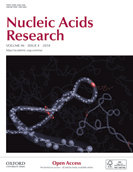- EN - English
- CN - 中文
RNA Cap Methyltransferase Activity Assay
RNA帽结构的甲基转移酶活性测定
发布: 2018年03月20日第8卷第6期 DOI: 10.21769/BioProtoc.2767 浏览次数: 7532
评审: Gal HaimovichAmanda GarnerC. Kiong Ho
Abstract
Methyltransferases that methylate the guanine-N7 position of the mRNA 5’ cap structure are ubiquitous among eukaryotes and commonly encoded by viruses. Here we provide a detailed protocol for the biochemical analysis of RNA cap methyltransferase activity of biological samples. This assay involves incubation of cap-methyltransferase-containing samples with a [32P]G-capped RNA substrate and S-adenosylmethionine (SAM) to produce RNAs with N7-methylated caps. The extent of cap methylation is then determined by P1 nuclease digestion, thin-layer chromatography (TLC), and phosphorimaging. The protocol described here includes additional steps for generating the [32P]G-capped RNA substrate and for preparing nuclear and cytoplasmic extracts from mammalian cells. This assay is also applicable to analyzing the cap methyltransferase activity of other biological samples, including recombinant protein preparations and fractions from analytical separations and immunoprecipitation/pulldown experiments.
Keywords: RNA (RNA)Background
The N7-methylguanosine cap at the 5’ end of an mRNA is a modification essential for proper eukaryotic mRNA processing, localization, and translation. The N7 methyl group is particularly critical for the mRNA life cycle, as it drastically increases the binding affinity of cap-binding proteins (Niedzwiecka et al., 2002) and protects mRNAs from cap-quality control surveillance mechanisms (Jiao et al., 2013). We recently reported that the mammalian RNA guanine-7 methyltransferase (RNMT) functions beyond its canonical role in nuclear co-transcriptional cap synthesis to participate in cytoplasmic RNA recapping (Trotman et al., 2017). We used the protocol presented here to demonstrate that the cap methyltransferase activity of cytoplasmic RNMT is unexpectedly robust relative to nuclear RNMT. Additionally, siRNA-mediated knockdown of RNMT greatly reduced the cap methyltransferase activity of cytoplasmic extracts, suggesting that RNMT is the predominant, if not only cap methyltransferase in the cytoplasm of mammalian cells. Nuclear RNMT exists as a heterodimer with RNMT-activating miniprotein (RAM, Gonatopoulos-Pournatzis et al., 2011), and we demonstrated that cytoplasmic RNMT also binds to RAM. Reduced cytoplasmic cap methyltransferase activity upon RAM knockdown indicated that RAM is a required cofactor for cytoplasmic RNMT.
This protocol is adapted from two earlier publications characterizing human RNMT (Cowling, 2010; Pillutla et al., 1998), with modifications that standardize generation of the substrate RNA, avoid cumbersome phenol-chloroform extractions with radioactive samples, and enable quantification of cap methyltransferase activity. We note that an alternative, nonradioactive assay has been reported for the analysis of cap methyltransferase reactions (Peyrane et al., 2007), but this method requires HPLC instrumentation that may not be available to all labs and may differ from the one presently reported in terms of sensitivity and sample compatibility. Additionally, a fluorescent assay for measuring cap methyltransferase activity was recently described (Aouadi et al., 2017), but this assay indirectly measures activity by monitoring the accumulation of S-adenosylhomocysteine (SAH) and may be incompatible with biological samples containing SAH. We hope that the level of detail in the protocol presented here enables future investigators to easily repeat and build upon our work.
Materials and Reagents
- 0.2 ml PCR tubes (e.g., BioExpress, GeneMate, catalog number: T-3225-1 )
- NucAway Spin Columns (Thermo Fisher Scientific, InvitrogenTM, catalog number: AM10070 )
- 1.7 ml plastic, sterile, RNase-free microcentrifuge tubes (e.g., BioExpress, GeneMate, catalog number: C-3262-1 )
- 10 cm or 15 cm culture dishes (e.g., Alkali Scientific, catalog numbers: TD0100 , TD0150 )
- Sterile nitrile gloves
- Cell lifters (e.g., BioExpress, GeneMate, catalog number: T-2443-4 )
- Sterile, RNase-free tips for P10, P20, P100, and P1000 pipets
- Plastic, disposable cuvettes for Bradford assay (e.g., Fisher Scientific, catalog number: 14-955-127 )
- Plastic wrap (e.g., Saran or Stretch-Tite brand)
- Paper labeling tape (e.g., Fisher Scientific, catalog number: 15-901-20H)
Manufacturer: Nevs, catalog number: 1590120H . - Polyethylenimine (PEI) cellulose TLC plates (Macherey-Nagel, catalog number: 801053 ; see Note 2)
- Immobilon-FL polyvinylidene difluoride (PVDF) membrane (Merck, catalog number: IPFL00010 )
- Scintillation vials compatible with liquid scintillation counter (e.g., DWK Life Sciences, WHEATON, catalog number: 225414 )
- U2OS cells (ATCC, catalog number: HTB-96 ) or HEK293 cells (ATCC, catalog number: CRL-1573 )
- P1 nuclease (United States Biological, catalog number: N7000 ), resuspended in RNase-free water to 0.625 U/μl
- Cap analog GpppG (New England Biolabs, catalog number: S1407 ), resuspended in RNase-free water to 10 mM
- Cap analog m7GpppG (New England Biolabs, catalog number: S1404 ), resuspended in RNase-free water to 10 mM
- RNase-free water (e.g., from a Millipore Synergy water purification system, 18.2 MΩ cm)
- Single-stranded DNA sense oligo
- Single-stranded DNA antisense oligo
- 5’ CATGCAAATTAACCCTCACTAAAGGGAGACCGGAATTCGAGCTCGCCCGGGGATC 3’ for T3 transcription template, resuspended in RNase-free water to 100 μM (e.g., synthesized by Integrated DNA Technologies (IDT); underlined is a T3 promoter sequence, bold sequence matches the transcribed 32-nucleotide (nt) pppRNA)
- 5’ GATCCCCGGGCGAGCTCGAATTCCGGTCTCCCTTTAGTGAGGGTTAATTTGCATG 3’ for T3 transcription template, resuspended in RNase-free water to 100 μM (e.g., synthesized by IDT)
- MEGAscript T3 Transcription Kit (Thermo Fisher Scientific, Ambion, catalog number: AM1138 )
- Pre-cast polyacrylamide mini-gels for urea polyacrylamide gel electrophoresis (urea-PAGE; e.g., Bio-Rad Laboratories, catalog number: 4566053 )
- Pre-cast polyacrylamide mini-gels for sodium dodecyl sulfate polyacrylamide gel electrophoresis (SDS-PAGE; e.g., Bio-Rad Laboratories, catalog number: 4568094 )
- 2x Laemmli Sample Buffer (Bio-Rad Laboratories, catalog number: 1610737 )
- SYBR Gold Nucleic Acid Gel Stain (Thermo Fisher Scientific, InvitrogenTM, catalog number: S11494 )
- RNA size marker (e.g., Thermo Fisher Scientific, InvitrogenTM, catalog number: AM7778 )
- 2x RNA loading dye (e.g., Thermo Fisher Scientific, Thermo ScientificTM, catalog number: R0641 )
- 40 U/μl RNaseOUT Recombinant Ribonuclease Inhibitor (Thermo Fisher Scientific, InvitrogenTM, catalog number: 10777019 )
- Recombinant triphosphatase-guanylyltransferase capping enzyme (see Note 1)
- [α-32P]GTP (3,000 Ci/mmol, PerkinElmer, catalog number: BLU506H250UC )
- RNA Clean & Concentrator-5 kit (Zymo Research, catalog number: R1016 )
- ScintiSafe Econo 1 scintillation fluid (Fisher Scientific, catalog number: SX20-5 )
Note: This product has been discontinued. - McCoy’s 5A medium (for U2OS cells; Thermo Fisher Scientific, GibcoTM, catalog number: 16600082 )
- Dulbecco’s modified Eagle medium (DMEM; for HEK293 cells; Thermo Fisher Scientific, GibcoTM, catalog number: 21013024 )
- Fetal bovine serum (FBS; Atlanta Biologicals, catalog number: S10350 )
- Phosphate-buffered saline (PBS; e.g., Thermo Fisher Scientific, GibcoTM, catalog number: 10010049 )
- Bio-Rad Protein Assay Dye Reagent Concentrate (Bio-Rad Laboratories, catalog number: 5000006 )
- Pre-stained protein marker (e.g., Bio-Rad Laboratories, catalog number: 1610393 )
- Bovine serum albumin (BSA; e.g., Fisher Scientific, catalog number: BP1600-100 ) dissolved in water to 1 μg/μl
- Antibody toward nuclear protein for Western blotting (e.g., rabbit polyclonal anti-nucleolin antibody, 1:5,000 working dilution, Sigma-Aldrich, catalog number: N2662 )
- Antibody toward cytoplasmic protein for Western blotting (e.g., mouse monoclonal anti-α-tubulin, 1:10,000 working dilution, Sigma-Aldrich, catalog number: T6199 )
- Appropriate secondary antibodies (e.g., for infrared imaging, Thermo Fisher Scientific, Invitrogen, catalog numbers: A-21109 and A-21058 , at 1:10,000 working dilutions)
- (Optional) Vaccinia Capping Enzyme (New England Biolabs, catalog number: M2080S )
- Dithiothreitol (DTT, Thermo Fisher Scientific, Thermo ScientificTM, catalog number: R0861 )
- RNase-free 10x Tris/borate/EDTA (TBE) buffer (e.g., Thermo Fisher Scientific, InvitrogenTM, catalog number: 15581 )
- Phenylmethylsulfonyl fluoride (PMSF; Thermo Fisher Scientific, Thermo ScientificTM, catalog number: 36978 )
- Isopropanol
- Tris (e.g., VWR, AMRESCO, catalog number: 0497 )
- Glycine (e.g., VWR, AMRESCO, catalog number: 0167 )
- SDS
- Methanol (e.g., Fisher Scientific, catalog number: A452SK-4 )
- Sodium chloride (NaCl; e.g., Fisher Scientific, catalog number: BP358 )
- 5 M NaCl (e.g., Thermo Fisher Scientific, catalog number: AM9759 )
- Concentrated HCl
- Tween 20 (e.g., Fisher Scientific, catalog number: BP337 )
- 32 mM S-adenosylmethionine (SAM; New England Biolabs, catalog number: B9003 )
- 3 M sodium acetate, pH 5.2 (e.g., Thermo Fisher Scientific, Thermo ScientificTM, catalog number: R1181 )
- Ammonium sulfate (e.g., Sigma-Aldrich, catalog number: A4418 )
- IGEPAL CA-630 (Sigma-Aldrich, catalog number: I8896 )
- 1 M Tris-HCl, pH 7.5 (e.g., AMRESCO, catalog number: E691 )
- 1 M magnesium chloride (MgCl2, e.g., Thermo Fisher Scientific, InvitrogenTM, catalog number: AM9530G )
- 500 mM ethylenediaminetetraacetic acid, pH 8.0 (EDTA; e.g., Thermo Fisher Scientific, InvitrogenTM, catalog number: 15575020 )
- Glycerol (e.g., Fisher Scientific, catalog number: BP229-1 )
- 1 M HEPES pH 7.3 (e.g., AMRESCO, catalog number: J848 )
- 2 M potassium chloride (KCl; e.g., Alfa Aesar, catalog number: J75896 )
- Protease inhibitor cocktail (Sigma-Aldrich, catalog number: P8340 )
- Phosphatase inhibitor cocktail 2 (Sigma-Aldrich, catalog number: P5726 )
- Phosphatase inhibitor cocktail 3 (Sigma-Aldrich, catalog number: P0044 )
- 1 M DTT (see Recipes)
- 1x Tris-buffered saline (TBS; see Recipes)
- 1x TBE (running buffer for urea-PAGE) (see Recipes)
- 20 mM DTT (see Recipes)
- 100 mM PMSF in isopropanol (see Recipes)
- 10x Tris/glycine (see Recipes)
- 10% (w/v) SDS (see Recipes)
- Tris/glycine/SDS running buffer for SDS-PAGE (see Recipes)
- Tris/glycine/methanol/SDS transfer buffer (see Recipes)
- 20x Tris-buffered saline (TBS) (see Recipes)
- 3% BSA in TBS (see Recipes)
- 40% (v/v) Tween 20 (see Recipes)
- TBS-T (see Recipes)
- 1 μM SAM (see Recipes)
- 500 mM sodium acetate, pH 5.2 (see Recipes)
- 0.4 M ammonium sulfate
- 10% IGEPAL CA-630 (v/v) in water (see Recipes)
- 10x annealing buffer (see Recipes)
- 4x capping buffer (see Recipes)
- YO Lysis Buffer (see Recipes)
- YO Buffer A (see Recipes)
- 10x cap methylation buffer (see Recipes)
Equipment
- Eye protection
- NanoDrop spectrophotometer (Thermo Fisher, model: NanoDropTM 1000 , catalog number: ND-1000)
- Lucite/Plexiglass acrylic benchtop shielding for handling 32P (e.g., Thermo Fisher Scientific, Thermo ScientificTM, catalog number: 6700-2418 )
- Geiger counter
- Metric (centimeter) ruler
- Scissors (e.g., Westcott, catalog number: ACM44217 )
- Graphite pencil
- Long (at least 18 cm) forceps or tongs (e.g., Fisher Scientific, catalog number: 15-186 )
- P10, P20, P100, and P1000 pipets
- Thermal cycler (e.g., MJ Research, model: PTC-200 )
- Heating block (e.g., Bioer, model: MB 101 )
- -80 °C freezer
- Handheld 254 nm UV light (e.g., UVP, model: 95-0016-14 )
- Liquid scintillation counter (e.g., Beckman Coulter, model: LS 6000IC )
- Water-jacketed incubator (e.g., Thermo Fisher Scientific, Thermo ScientificTM, model: Forma® Series II) set to 37 °C with 5% CO2
- Refrigerated centrifuge (Eppendorf, model: 5415 R )
- Programmable rotator-mixer (Grant Instruments, model: PTR-30 ) at 4 °C and set to 10 rpm orbital rotation
- UV-vis spectrophotometer (e.g., Beckman Coulter, model: DU 640 ) set to 595 nm
- Electrophoresis system for PAGE and membrane transfer (e.g., Bio-Rad Laboratories, catalog number: 1660828EDU )
- Opaque western blot incubation boxes (e.g., LI-COR, catalog number: 929-97205 )
- Western blot imaging system (e.g., LI-COR, model: Odyssey Imaging Systems )
- Rectangular glass TLC chamber (e.g., Miles Scientific, model: A70-22 , formerly Analtech)
- Electric hair dryer (optional)
- Storage phosphor screen (e.g., GE/Amersham Biosciences)
- Light eraser for storage phosphor screen (e.g., Molecular Dynamics Image Eraser)
- Typhoon imaging system (e.g., GE Healthcare, Amersham Biosciences, model: Typhoon 9200 )
Software
- Microsoft Excel software
- ImageQuant TL software
Procedure
文章信息
版权信息
© 2018 The Authors; exclusive licensee Bio-protocol LLC.
如何引用
Trotman, J. and Schoenberg, D. R. (2018). RNA Cap Methyltransferase Activity Assay. Bio-protocol 8(6): e2767. DOI: 10.21769/BioProtoc.2767.
分类
分子生物学 > RNA > RNA 加帽
生物化学 > 其它化合物 > 三磷酸核苷
您对这篇实验方法有问题吗?
在此处发布您的问题,我们将邀请本文作者来回答。同时,我们会将您的问题发布到Bio-protocol Exchange,以便寻求社区成员的帮助。
提问指南
+ 问题描述
写下详细的问题描述,包括所有有助于他人回答您问题的信息(例如实验过程、条件和相关图像等)。
Share
Bluesky
X
Copy link














